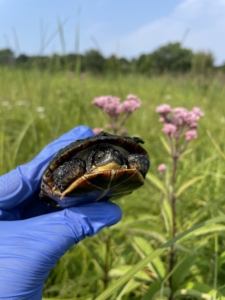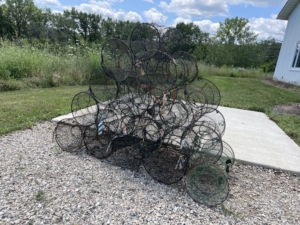
Hello everybody!
This week we had our second-to-last week, and we did some more trapping to wrap up our numbers for the summer. As researchers, we aim to have an amount of captures every year to accurately assess our turtle populations and develop reliable statistical analyses. Fortunately, this year has been a very fruitful one and our turtle numbers remained high across the season.
The highlight of this week for me was catching my first wild, all brand-new turtle in my traps. It was so satisfying to find a turtle that has never ever been caught before and even better to name it. It was such a rewarding moment!

An interesting fact that I learned this week was how different the annuli rings of turtles look based on whether they are wild born, or head starts. Annuli rings are the lines within the scutes of a turtle’s shell, and they can be used to estimate an individual’s age. During our physical exams, we usually measure the annuli rings in the left pectoral scute of the plastron to determine age. What I learned was that the space between each annulus ring is typically wider in head starts than wild-born turtles because head starts are fed a constant diet and grow faster than their wild counterparts. Cool, right?

As usual, our week ended with some trap cleaning and bleaching. After pulling our traps every week, we always wash and disinfect our traps to avoid spreading any pathogens between field sites. Additionally, if there are any broken traps, we always have a repair workshop at the end of the week to sew up and restore our traps.
As you can see in the picture above, 15 out of our 40 traps needed sewing this week. While it is not my favorite task to do, I do enjoy the crafting aspect of repairing traps.
That’s all from me. Have a fantastic weekend!
By: Javelis Marín Castro (she/ella)
